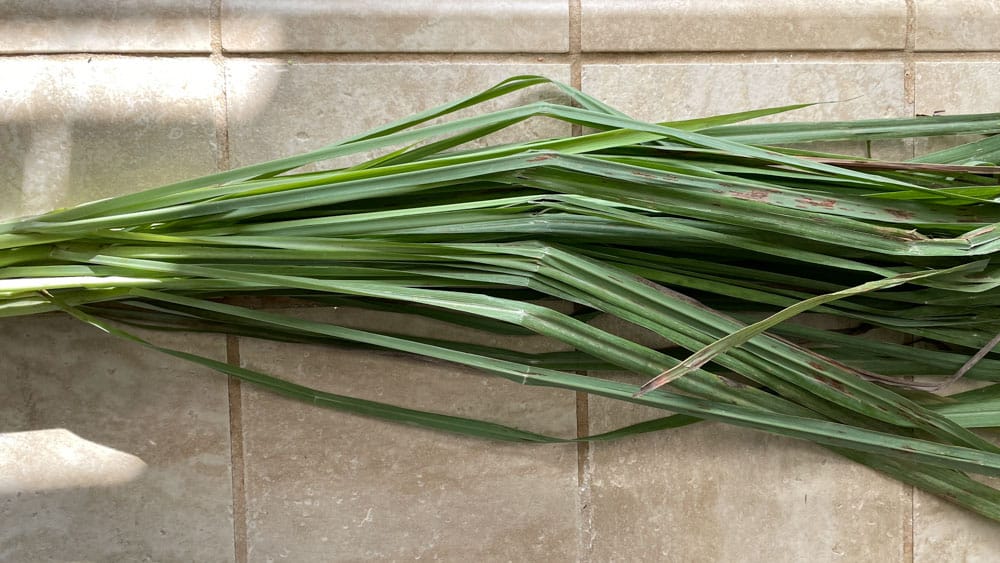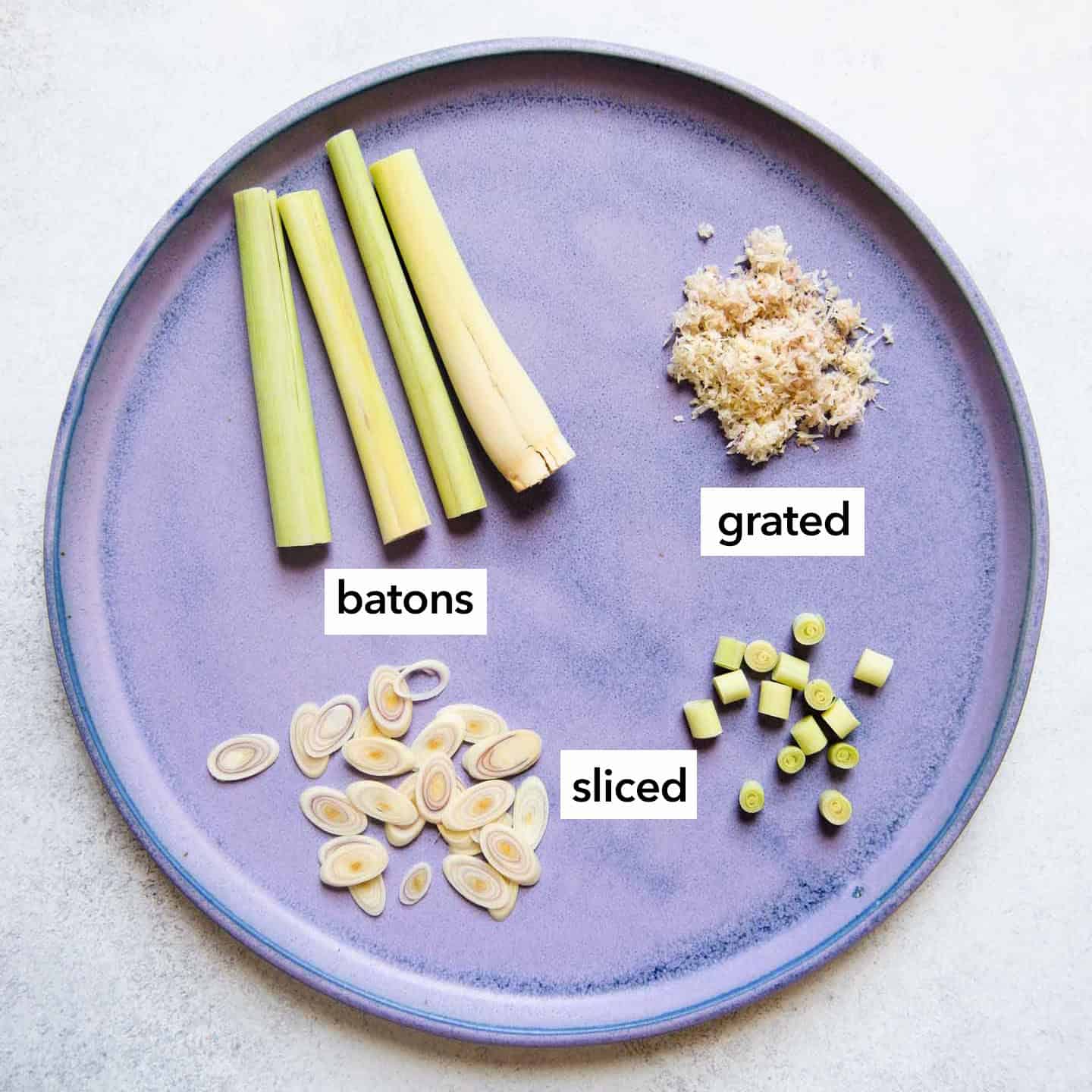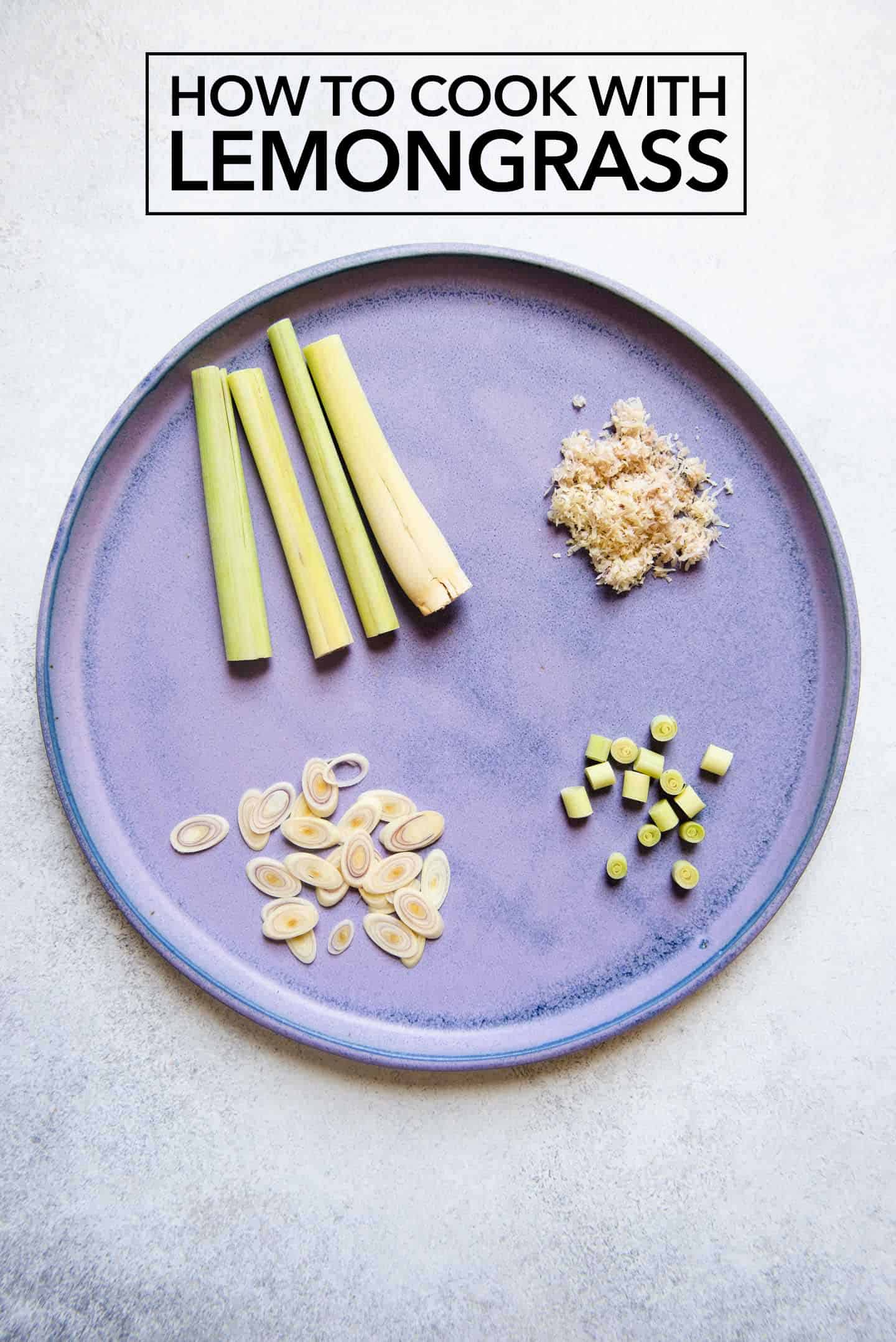VIDEO: WATCH HOW TO PREPARE LEMONGRASS
Written by Lisa Lin & Diann Leo-Omine. Photos & Video by Lisa Lin.
While I didn’t grow up using lemongrass, it’s an ingredient that I’ve grown to love after becoming more familiar with Vietnamese and Thai cuisine. Once I learned how to cook with lemongrass, I started adding it to soups and curries. Though subtle, the citrusy, herbaceous notes of lemongrass brighten the flavors of a dish.

WHAT IS LEMONGRASS?
Lemongrass is a fibrous stalk with light citrusy flavor. Although I discovered lemongrass through Vietnamese and Thai cuisine, it is also used in other Southeast Asian and South Asian cooking (Malaysian, Indian, etc.). Lemongrass is usually grown in the ground, with most of the stalk buried underneath the soil and long thin leaves shooting up from the top. By the time the lemongrass stalks reach our farmers markets or grocery stores, these long leaves are often trimmed. What’s left are lemongrass stalks that are over a foot long with a few inches of thin leaves at the top (see photo above).
You can use lemongrass to flavor broths, marinades, or use it to make curry pastes. If you’ve never cooked with lemongrass, it might be intimidating because the stalks of lemongrass are dense and firm. I certainly was intimidated. Over time, you’ll get a feel for which parts of the lemongrass to use. The following are tips on how to cook with lemongrass.
HOW TO PICK LEMONGRASS
The best place to get fresh lemongrass stalks will be at the farmers market. I’m fortunate that the Asian farmers market in Sacramento has many vendors that sell fresh lemongrass that are bundled up with 7 to 10 stalks per bunch. The stalks are usually green and plump with leaves that haven’t wilted.

Once in a blue moon, I’ll see stalks of lemongrass with leaves that haven’t been trimmed yet (see photo above). The thin leaves can be about 2 feet long!
You can also find lemongrass in the refrigerated sections of Asian supermarkets or your grocery store’s refrigerated produce section, close to the ginger root and Asian vegetables. Try to find stalks that are light green. The tops of the stalks should be green as well, not thin and woody. They shouldn’t be yellow or brown because that’s a sign that they have been sitting there for a while.
Of course, if you don’t have much of a choice at the grocery store, select stalks that still look relatively plump. You can always peel off the dry outer layers and use the core of the stalk for cooking.
HOW TO COOK WITH LEMONGRASS
When I first used lemongrass for a recipe, I was perplexed by the directions telling me that I should peel off “several” layers and use the “tender core” of the stalk. I thought that meant peeling away 4 or 5 layers of the stalk to get to the soft, bendable center of the lemongrass stalk. It didn’t make much sense to me as I was wasting so much of the stalk. As I cooked with lemongrass more, I realized that peeling all those layers wasn’t necessary.

First, slice off about ½ inch from the bottom of the stalk. It’s often the part of the lemongrass that is browning or drying out anyway. The lemongrass leaves will also be easier to peel off. Then, slice off the top of the stalk to trim away the thin leaves. Although they retain some flavor, I find them to be too much of a hassle to deal with, so I toss them away. However, Andrea Nguyen has a recipe for how to use the lemongrass leaves to make tea.
By the way, I also like Andrea’s tip about honing your knives with a honing steel after chopping lemongrass. Because lemongrass is quite tough, your knives may dull as you slice through the stalks.
Afterwards, peel off 1 or 2 of the outer layers of the stalk. The amount of layers that you peel depends on the freshness of the lemongrass. For the lemongrass that you see in the top of the post, I usually peel off 2 layers. If you are working with stalks that aren’t as fresh, you may need to peel off an extra layer or more. Since lemongrass is grown in the ground, there’s often dirt that’s clinging to the stalk. Rinse the lemongrass with water if you see visible dirt.
If you’re making a soup or broth, slice the stalk into 3-inch sections. Then, bash each section with a kitchen mallet or meat tenderizer, until you see the stalk split open slightly. This technique releases the oils from the stalks. Most of my lemongrass recipes are soups or jook (congee/rice porridge), so this is my preferred method of preparing lemongrass.
Alternatively, you can slice the stalk into rings. I’ve seen them sliced into 1/2-inch rings for soups in some Thai restaurants. If you want to use them for stir fries, you may want to slice them very thinly (almost paper thin) so that they’re easier to eat. Otherwise, the lemongrass will seem tough and fibrous.
If you want to infuse a sauce or marinade with lemongrass, I recommend grating the lemongrass with a microplane zester/grater. That way, the lemongrass will be easy to combine with the other ingredients and it’ll be easy to eat. Keep in mind that the preparation method used depends on the recipe.
LEMONGRASS PASTE
If you can’t find lemongrass stalks at all, you can use lemongrass paste, like the one made by Gourmet Gardens. The paste usually comes in a tube and is sold in the refrigerated herbs section. The flavor of the paste is very good, but note that it is not vegan (it contains whey).
FREEZING DIRECTIONS
Lemongrass will start to go bad in the fridge after a few weeks. To store for a longer time, freeze the lemongrass. Trim, rinse, and dry off the stalks of lemongrass. Slice them into 3-inch sections. Transfer them to a freezer bag and use within a few months. It’s even better if you have a vacuum sealer to seal the bag to prevent freezer burn.

RECIPES USING LEMONGRASS
SOUPS & CURRIES
- Thai-Inspired Vegetable Red Curry
- Vegan Congee
- Thai-Spiced Butternut Squash Soup
- Vegan Savory Tang Yuan
- Creamy Tom Yum Goong (from Hot Thai Kitchen)
SALADS
- Banh Mi Salad with Lemongrass Shrimp & Shallot Vinaigrette
- Lemongrass Chicken Noodle Salad
- Spring Salad with Lemongrass Vinaigrette
STIR FRIES
How To Cook With Lemongrass
Ingredients
- fresh lemongrass stalks
Instructions
- Slice off about 1/2 inch from the bottom of the stalk. Then, slice off the top of the stalk to trim away the thin leaves. Although they retain some flavor, I find them to be too much of a hassle to deal with, so I toss them away.
- Next, peel off 1 or 2 of the outer layers of the stalk. The amount of layers that you peel depends on the freshness of the lemongrass. If you are working with stalks that aren’t as fresh, you may need to peel off an extra layer or more. Since lemongrass is grown in the ground, there’s often dirt that’s clinging to the stalk. Rinse the lemongrass with water if you see visible dirt.
- Lemongrass Batons: If you’re making a soup or broth, slice the stalk into 3-inch sections. Then, bash each section with a kitchen mallet or meat tenderizer, until you see the stalk split open slightly. This technique releases the oils from the stalks. Most of my lemongrass recipes are soups or jook (congee/rice porridge), so this is my preferred method of preparing lemongrass.
- Sliced Lemongrass: You can slice the stalk into thin rings. I’ve seen them sliced into 1/2-inch rings for soups in some Thai restaurants. If you want to use them for stir fries, you may want to slice them very thinly (almost paper thin) so that they’re easier to eat. Otherwise, the lemongrass will seem tough and fibrous.
- Grated Lemongrass: If you want to infuse a sauce or marinade with lemongrass, I recommend grating the lemongrass with a microplane zester/grater. That way, the lemongrass will be easy to combine with the other ingredients and it’ll be easy to eat. Keep in mind that the preparation method used depends on the recipe.
Video
Notes




Dawn says
Thanks for the info!
Lisa Lin says
You’re welcome!
Hennessy says
Super helpful, Lisa! Wish I read this before I started throwing lemongrass into my Instant pot today!
K says
Ty!
Shelly Mitchell says
Excellent, lucid, understandable directions. I love lemongrass and have been making a paste of it with garlic, ginger and a touch of oil. I feel that it’s not as flavorful grinding it up, so I am so grateful for your tips!
Thank you!
Lisa Lin says
Thank you, Shelly!
tony says
cool idea!!!
Ellen says
Thank you for the information, I’m growing it and wasn’t sure how to use it.
Judith Dearborn says
Hi Lisa: I just want to say how happy I am to see your website. I simply asked the question to Google how to cook with Lemongrass and your site popped up. You were explicit about the many uses of Lemongrass and you posted some delicious recipes which I will definitely use. Thanks so much. Judy Dearborn
Amy Marie Orozco says
Thank you for your video on using lemongrass. I appreciated the simplicity and found it very helpful.
Sam Visser says
I find sliced lemongrass very useful too. Thanks for sharing these amazing techniques.
John Kost says
This is helpful. We are actually growing lemon grass in pots here in Virginia. Do your instructions about how to prepare it if you’re picking it, too?
Alan Stone says
Thanks,I have just started growing here in Melbourne Australia. Your instructions will be very valuable to me. Alan (Stone)
Lisa Lin says
Thanks, Alan!
Valia Kriston says
I did not make this recipe – yet. But I wanted to thank you for your comprehensive tutorial on lemongrass. I have had it may times in Thai food, but just recently wanted to add an Asian twist to a chicken stew with coconut cream. Your information was so thorough that I did not feel the need to consult multiple sources as I usually do. Thank you so much.
Sue C says
I grew my own lemongrass this summer here in Massachusetts. The plant is huge! I will harvest tomorrow so thank you for all this information! Sue
Lisa Lin says
Enjoy the harvest, Sue!
Melody says
Thank you for the videos…very helpful for sure
Lisa Lin says
I appreciate that feedback, Melody! Makes me know that I need to make more for my posts!